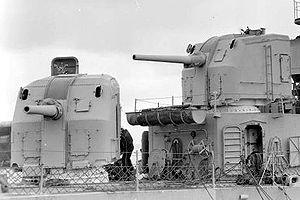![]() The Pacific War Online Encyclopedia
The Pacific War Online Encyclopedia
|
| Previous: U.S. 5"/25 AA Gun | Table of Contents | Next: U.S. 5"/51 Gun |

U.S. Navy. Via Wikimedia Commons
| Bore |
5" 127mm |
| Ammunition type |
Semi-fixed shell (antiaircraft,
common, or illuminating) |
| Weight of
projectile |
55 lbs 25 kg |
| Velocity | 2600 feet per second 792 meters per second |
| Maximum elevation | 85 degrees |
| Range | 18,200 yards 16.640 meters |
| Altitude | 37,200 feet 11, 340 meters |
| Firing cycle | 3 seconds |
| Loadout |
300 rounds per gun was typical,
but the Bensons could carry 360 rounds
per gun and the Fletchers 425 rounds per gun.
Some destroyers were carrying
over 500 rounds per gun at the time of the surrender. |
A true war-winning weapon, the U.S. Navy’s 5”/38 dual-purpose
gun was standard main armament on U.S. destroyers and
standard secondary armament on larger U.S. warships built during the
war. Those that could be spared were given to Britain as Lend-Lease.
Though the 5”/38 was effective against unarmored ships and shore installations, it was in the antiaircraft role that this gun excelled. Its semi-automatic design (the breech automatically opened after firing and ejected the powder cartridge) and capability of being loaded at any angle of elevation yielded an excellent rate of fire, better even in practice than in its official specifications. Japanese pilots sometimes referred to it as the 5” machine gun. Crews were heavily drilled to reduce the firing cycle, not just to improve the rate of fire, but to ensure that the "dead time" between setting the timed fuse and firing the gun was as short as possible to avoid spoiling the fire control solution. Its Mark 37 director was highly advanced, the gun had a high reach, and it was easily and quickly traversed to track fast-moving aircraft. None of its performance statistics was outstanding, but all were very good, making it an all-around excellent design.
But perhaps the deadliest aspect of the weapon was that it was capable of firing a large VT shell, which contained a radar-based proximity fuse. This made the shell three times as effective as a conventional timed shell, in spite of a relatively high dud rate due to the complex electronics. Between the Hellcats and the 5”/38s, conventional aerial attack on an American task group became tantamount to suicide by the end of the war. Hence, the Japanese tried to make the best of a bad situation by turning to kamikaze tactics.
The Mark 37 director was as costly as it was effective at $353,000 for a complete system. As a result, there was some hesitation using it on auxiliaries, and it is not clear if or when the 5"/38 guns on auxiliaries were equipped with the Mark 37 rather than follow-the-pointer fire control.
The gun was of monoblock construction and used a sliding breech block. The bore was chromium plated for long life, and the gun proved reliable in service. During the Okinawa campaign, so much 5"/38 ammunition was expended that concerns were raised about excessive barrel wear. Destroyers Hall and Richard P. Leary, which
had both expended about 4270 rounds per gun, were ordered to fire
practice rounds to determine the effects of barrel wear on accuracy.
The range pattern was 260 yards at 6000 yards (240 meters at 5500
meters) and 470 yards at 12,000 yards (430 meters at 11,000 meters),
both within the nominal accuracy.
The gun was typically mounted in twin turrets on large warships and the largest destroyer classes. The ammunition loadout on these ships was 500 rounds per gun, of which 55 rounds could be stored as ready ammunition in the service compartment immediately beneath the turret. Most destroyers and a few older battleships and cruisers mounted the gun in single turrets. The gun was also mounted in single open mounts on older warships, on auxiliaries, and on newer ships where there was not enough room for a turret. Curiously, the gun was mounted on most escort carriers in a single low-angle mount (maximum elevation 27 degrees) that had little antiaircraft capability. This was made necessary by the location of the mounts under the overhanging flight deck.
The gun crew consisted of a gun captain, pointer, trainer,
sight-setter, fuse-setter, hot shellman, and a variable number of
loaders and handling room crewmen.
 |
 |  |
 |
 |
 |
 |
 |
 |
References
Roscoe (1953)
Wildenberg (1996)
The Pacific War Online Encyclopedia © 2007, 2009-2011, 2014 by Kent G. Budge. Index